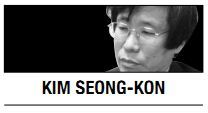Recently, I have met many Koreans who were very proud of their country’s remarkable economic growth and cultural popularity overseas. In Seoul, a young Korean woman from overseas told me, “I am so impressed by Korea’s astonishing development and tremendous social change. I feel like I’m in a truly advanced country.” In Washington, D.C. a Korean-American told me, “When I went to watch a baseball game the other day, I saw the cheerleaders and the audience dance Psy’s ‘Horse Dance’ together after the first half. Watching them, I was proud of my country.”

Notwithstanding these optimistic observations of South Korea, there are also many Koreans who are equally disappointed in their country’s backwardness in certain areas. The woman from the U.K. confessed to me, “Much as I’m fascinated by the dynamic energy of my country, Korea baffles me nonetheless. Korea is so advanced in many respects and yet, she is so underdeveloped in certain aspects.”
The Korean-American in D.C., too, pointed out the contradictions of Korean society, aptly saying, “Korea is a foremost country when it comes to electronics and automobiles, trade ranking and economy size. Yet, I find so many Koreans still narrow-minded and jingoistic.”
Perhaps one of the most outstanding backward aspects of Korean society is the chronic disease of ideological warfare between the left and the right, or between the progressives and the conservatives. The polarity already tore the Korean Peninsula apart between the north and south, and then the east and west as well.
That is why in today’s Korean society both the 21st century (electronic technology) and the 19th century (ideological skirmishes) curiously co-exist. Not knowing the world has changed, Korean politicians, divided by two different political ideologies, still spitefully fight in the political arena, as if they were living in the ancient times of the gladiators. The problem is that the ideological warfare is tearing apart the nation and the Korean people’s psyche.
In the 1960s, American society was divided by the Freaks and the Squares, that is to say, by the liberals and the conservatives. Interestingly, during the Roh administration, Korean progressives, too, called their political foes, “conservative squares” and in turn Korean conservatives nicknamed their political opponents the “leftwing progressives.” However, there are distinctive, radical differences between the two countries.
During the Great Depression era, for example, most American leftists tended to be hostile, belligerent pro-Soviet radicals, even though some of them were disappointed later in the Stalin’s Moscow Trials that massacred so many political dissidents. In the 1960s, however, American liberals differentiated themselves from the radical paleo-Leftists of the 1930s and called themselves the “New Left.” Therefore, those who belonged to the New Left were not ideologically charged, dogmatic Marxists, but rather the liberals, romantics and counter-culture hipsters.
Unfortunately, today’s Korean leftists seriously lack the spirit and qualities of the American New Left. Indeed, Korean Leftists these days are undeniably far from being liberal, romantic or flexible, even though they have flocked under the banner of “progressivism.” Instead, they are stubbornly rigid, stiff and even cadaveric.
A progressive in reference would be someone who is foremost in his or her field or vision. Strangely, however, few Korean progressives today seem to be genuinely progressive and as a result, it is hard to find a foremost, cutting-edge visionary or revisionary progressive in today’s Korean society. Perhaps Korea, too, urgently needs the New Left movement which is free from the petrified Marxist dogma.
As for the New Right, we already have one. But our New Right movement is somewhat dubious. Instead of coming up with a novel idea or a modified version of traditional conservatism, our New Right people today seem to be busy seeking political power while skirmishing with the leftists. The New Right should clearly differentiate itself from the old conservatives through the alteration of consciousness and new perspectives. And they should be able to persuade us why conservatism is good and necessary. Otherwise, people would find the New Left more attractive.
Disappointed both in the progressives and the conservatives, we desperately want to see the birth of a third possibility that Leslie Fiedler called “the New Mutant,” a hybrid of liberalism and conservatism. As a mutant, it may look weird at first and yet, this third possibility will surely solve the problem of chronic bipolarity that has plagued Korean society. Historically, great writers and intellectuals have always sought the third possibility, avoiding both extremes. Indeed, we are now watching the advent of the age of hybrid cultures and mutants, both of which are much better and stronger than the purebred.
Meanwhile, we are hopelessly caught in the crossfire of power politics and ideologies. In this small country we love so much, we often feel sad and become pessimistic, witnessing the tragic ideological confrontations and clashes. But we cannot lose hope. As Max Ehrmann once wrote, “With all its shams, drudgery and broken dreams, it is still a beautiful world. Be cheerful. Strive to be happy.”
By Kim Seong-kon
Kim Seong-kon is a professor of English at Seoul National University and president of the Literature Translation Institute of Korea. ― Ed.








